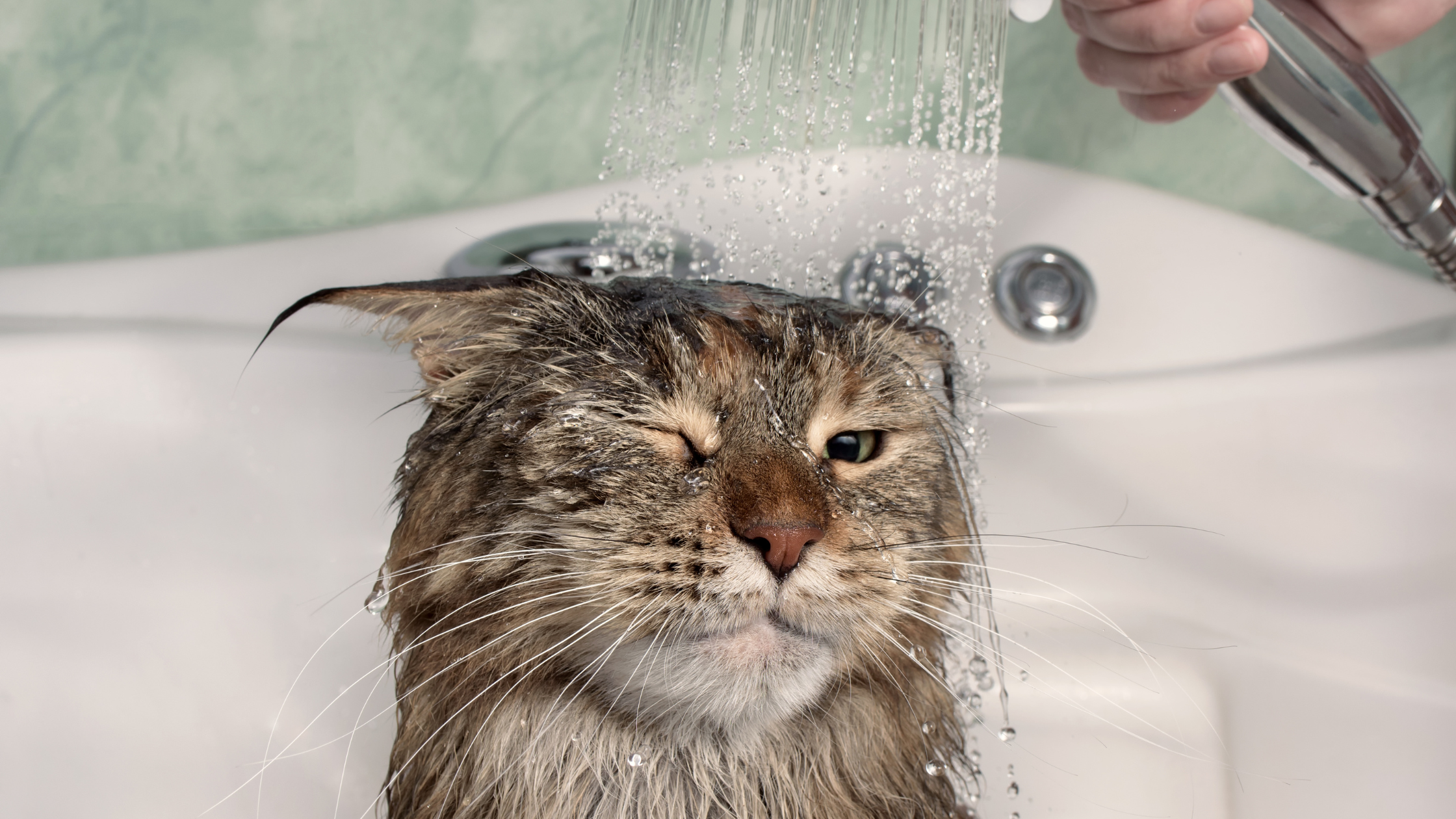Picture this: You've just discovered your cat has somehow managed to coat herself in maple syrup from the pancake incident this morning. Armed with determination and a bottle of pet shampoo, you approach the bathroom. Five minutes later, you're soaking wet, sporting three new scratch marks, and your cat is hiding under the bed—still sticky. Sound familiar?
If you've ever attempted to bathe a cat, you know it often feels like trying to give a bath to a tiny, furry tornado with razor-sharp claws. But here's the thing: your cat isn't being dramatic (well, not entirely). There's actually 30 million years of evolution telling them that water is the enemy.
Why Do Cats Hate Water So Much?
Your cat's ancestor, the African wildcat, evolved in the desert regions of the Middle East and Africa—places where large bodies of water were about as common as, well, cats who enjoy baths. Unlike dogs who had wolves swimming after prey, cats developed in environments where staying dry meant staying alive.
Dr. Cavey, DVM, explains: "It is a well known fact that most cats dislike water and situations where they lose their freedom of movement and cannot control their environment. Being forced into a bathtub is a perfect example of this lack of control. Their 'fight or flight mechanism' will commonly kick in.
A Quick History Lesson: Cats and Baths Through the Ages
Here's something fascinating: Even the ancient Egyptians, who literally worshipped cats and mummified them with precious oils, never gave them baths. They understood what many of us learn the hard way—cats are self-cleaning machines.
In medieval times, monks who kept cats to protect manuscripts from mice never mentioned bathing them. Though one frustrated scribe in 1420 did leave us this gem of a complaint when his cat peed on his manuscript: "Cursed be the pesty cat that urinated on this book!" Even back then, cats were avoiding water while still managing to cause chaos.
The French even had a medieval saying: "Aussi aise que ung chat qui ce baingne" (As uneasy as a bathing cat). So if you feel like you're fighting a losing battle, take comfort—humans have been struggling with this for literally centuries.
But Wait, Some Cats Actually Like Water?
Before you think your water-loving cat is broken, know that some breeds are natural swimmers:
- Turkish Vans: Known as "swimming cats," they evolved near Turkey's Lake Van and have water-resistant fur
- Maine Coons: These gentle giants worked on ships and have dense, water-repellent coats
- Bengals: With Asian leopard cat ancestry, many have slightly webbed feet
- Norwegian Forest Cats: Viking ship cats with waterproof double coats
If your cat tolerates or even enjoys water, you might have some of these breeds in their ancestry—or you just have a wonderfully weird cat (embrace it!).
Do Cats Really Need Baths?
Short answer: Usually, no.
Long answer: It depends on your specific cat.
Cats spend up to 50% of their waking hours grooming themselves. Their tongues are basically built-in brushes with tiny backward-facing hooks that remove dirt and distribute natural oils. Most healthy cats never need a traditional bath.
When bathing becomes necessary:
- Your cat got into something toxic or sticky (like our maple syrup friend)
- Senior cats who can't groom themselves properly
- Overweight cats who can't reach certain spots
- Long-haired breeds prone to matting (Persians, Himalayans)
- Sphynx cats who need regular skin care
- Medical conditions requiring medicated baths
The Revolutionary Alternative: No-Rinse Solutions
Remember that pancake syrup situation? This is where waterless foam shampoos become a game-changer. Products like SilvaPlex® No Rinse Foam Shampoo offer a stress-free way to clean your cat without the bathroom battlefield.
How Does Waterless Shampoo Work?
Think of it like dry shampoo for humans, but specifically formulated for cats:
- Apply foam directly to your cat's fur
- Gently massage it in (most cats actually enjoy this part)
- Towel dry—no water required
- Brush to distribute and remove excess
The foam lifts dirt and oils without triggering your cat's water-related fight-or-flight response. It's particularly brilliant for spot-cleaning accidents or freshening up between professional grooming sessions.
Your Questions Answered
Q: How often should I bathe my indoor cat? A: The surprising truth? Most cats never need frequent baths since they're fastidious self-groomers. However, the ideal frequency really depends on your cat's specific situation:
General Guidelines by Cat Type:
- Short-haired cats: Usually only when they get into something messy
- Long-haired cats (Persians, Maine Coons): Every 4-8 weeks to prevent matting
- Hairless breeds (Sphynx): Weekly baths to manage skin oil buildup
- Senior or obese cats: Every 4-6 weeks if they can't groom properly
- Most healthy adult cats: A good brushing is often all they need!
Signs Your Cat Actually Needs a Bath:
- They've gotten into something messy or potentially toxic
- You notice a strong odor that doesn't go away with brushing
- They have visible dirt or grease that grooming isn't removing
- Flea or parasite treatment requires it
- Your allergies are acting up (bathing can reduce allergen proteins)
- Your vet recommends it for a medical condition
Warning: Don't Overdo It! Too-frequent bathing strips beneficial oils from your cat's skin and coat, leading to irritation, dryness, and even more grooming issues. This is where waterless options like SilvaPlex® No Rinse Foam Shampoo shine—they clean effectively without stripping those natural oils your cat needs for healthy skin and a lustrous coat.
Q: My cat absolutely needs a bath. How can I make it less traumatic? A: Try these tricks:
- Use lukewarm water (not hot or cold)
- Place a rubber mat in the tub for grip
- Keep water shallow—just a few inches
- Work quickly and calmly
- Have towels ready and warm
- Consider waterless alternatives first
Q: Are waterless shampoos as effective as traditional baths? A: For routine cleaning and spot treatments, yes! They remove surface dirt, oils, and odors effectively. For deep cleaning or medical treatments, traditional baths might still be necessary.
Q: My cat has never had a bath and she's 10 years old. Is that okay? A: If she's healthy, grooms herself regularly, and doesn't have any hygiene issues, she's perfectly fine! Many cats live their entire lives without needing a bath.
Making Peace with Your Cat's Watery Nemesis
Understanding why your cat treats bath time like a scene from a horror movie can help you approach grooming with more empathy—and better strategies. Your cat isn't being difficult; they're responding to millions of years of evolutionary programming that says "water = danger."
For those times when cleaning is necessary, products like SilvaPlex® No Rinse Foam Shampoo bridge the gap between your cat's natural instincts and modern hygiene needs. With its hypoallergenic, fragrance-free formula featuring chelated silver for antimicrobial properties, vitamin E for coat health, and hydrolyzed wheat protein for fur strength, it provides thorough cleaning without the trauma.
The best part? No more bathroom battles, no more stress scratches, and no more hiding under the bed. Just a clean, happy cat and an intact human-feline relationship.
Because at the end of the day, shouldn't grooming strengthen your bond with your cat, not test it?


